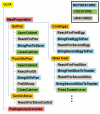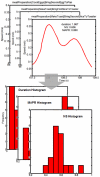Assessing upper extremity motor function in practice of virtual activities of daily living
- PMID: 25265612
- PMCID: PMC4532436
- DOI: 10.1109/TNSRE.2014.2360149
Assessing upper extremity motor function in practice of virtual activities of daily living
Abstract
A study was conducted to investigate the criterion validity of measures of upper extremity (UE) motor function derived during practice of virtual activities of daily living (ADLs). Fourteen hemiparetic stroke patients employed a Virtual Occupational Therapy Assistant (VOTA), consisting of a high-fidelity virtual world and a Kinect™ sensor, in four sessions of approximately one hour in duration. An unscented Kalman Filter-based human motion tracking algorithm estimated UE joint kinematics in real-time during performance of virtual ADL activities, enabling both animation of the user's avatar and automated generation of metrics related to speed and smoothness of motion. These metrics, aggregated over discrete sub-task elements during performance of virtual ADLs, were compared to scores from an established assessment of UE motor performance, the Wolf Motor Function Test (WMFT). Spearman's rank correlation analysis indicates a moderate correlation between VOTA-derived metrics and the time-based WMFT assessments, supporting the criterion validity of VOTA measures as a means of tracking patient progress during an UE rehabilitation program that includes practice of virtual ADLs.
Figures







References
-
- Edwards D, Hahn M, Baum C, Perlmutter M, Sheedy C, Dromerick A. Screening patients with stroke for rehabilitation needs: Validation of the post-stroke rehabilitation guidelines. Neurorehab. Neural Re. 2006;20(1):42–48. - PubMed
-
- Johansson B. Current trends in stroke rehabilitation. A review with focus on brain plasticity. Acta Neurol. Scand. 2011;123(3):147–159. - PubMed
-
- Hallett M. Plasticity of the Human Motor Cortex and Recovery from Stroke. Brain Res. 2001 Oct;36(2-3):169–174. - PubMed
-
- Nudo R. Adaptive Plasticity in Motor Cortex: Implications for Rehabilitation After Brain Injury. J. of Rehabil. Med. 2003 May;41(Suppl):7–10. - PubMed
Publication types
MeSH terms
Grants and funding
LinkOut - more resources
Full Text Sources
Medical

